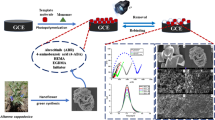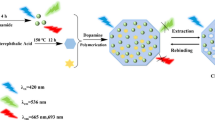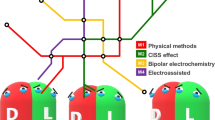Abstract
Ferrocene is a stable metallocene complex with aromatic high-electron π-conjugated system and sandwich structures. We first prepared and characterized a novel ferrocenediamide bridged bis(β-cyclodextrin) chiral stationary phase (FeCDP) to explore its chiral separation function. Its HPLC performance was systematically evaluated by basic, acidic, amphoteric and neutral chiral probes, including triazoles, profens, flavanones, amino acids and β-blocker drugs in reversed-phase and polar organic modes, respectively. The results showed that FeCDP successfully resolved 44 kinds of tested analytes (Rs = 0.66–4.38), of which 36 were completely separated (Rs ≥ 1.5). The best resolutions of different types, such as hexaconazole, ketoprofen, 3'-hydroxyflavanone, phenylalanine and arotinolol on FeCDP were reached at 3.06, 1.90, 4.38, 1.89 and 2.12 in a short time, respectively. Especially, FeCDP could completely resolve imazalil (Rs = 1.97), ketoprofen (Rs = 1.90), dansylated arginine (Dns-Arg, Rs = 1.50), pindolol (Rs = 1.42), bevantolol (Rs = 1.41), which were very difficult to be resolved on the conventional CDCSPs. However, under optimal condition, the ordinary CDCSP could only separate 19 analytes with low resolutions (Rs = 0.29–1.27). Compared with the reported similar stationary phases, the HPLC performance of FeCDP was also further improved. Based on the above comparison results, the satisfactory enantioselectivity of FeCDP may be mainly due to the fact that the “pseudo-cavity” composed of two CDs and a ferrocene diamide, could provide cooperative inclusion for analytes. Meanwhile, the large π-conjugated ferrocenediamide bridging group could also provide hydrogen bonding, π–π stacking, dipole–dipole and hydrophobic interactions, which may promote the chiral recognition effect of FeCDP. Bridge CD-CSP was a versatile chiral separation material in drugs analysis.
Graphical Abstract







Similar content being viewed by others
References
Agranat I, Caner H, Caldwell A (2002) Putting chirality to work: The strategy of chiral switches. Nat Rev Drug Discovery 1:753–768. https://doi.org/10.1038/nrd915
Cui X, Zhong Q, Zhang X, Li H, Wang X, Luo F, Cheng Y, Chen Z (2019) Progress on analysis of chiral pesticide enantiomers residues in agricultural products based on chromatographic method. J Instrum Anal 38:249–262
Zhou Q, Yu LS, Zeng S (2014) Stereoselectivity of chiral drug transport: a focus on enantiomer-transporter interaction. Drug Metab Rev 46:283–290. https://doi.org/10.3109/03602532.2014.887094
Muller MD, Poiger T, Buser HR (2001) Isolation and identification of the metolachlor stereoisomers using high-performance liquid chromatography, polarimetric measurements, and enantioselective gas chromatography. J Agric Food Chem 49:42–49. https://doi.org/10.1021/jf000857f
Xiao Y, Ng SC, Tan TTY, Wang Y (2012) Recent development of cyclodextrin chiral stationary phases and their applications in chromatography. J Chromatogr A 1269:52–68. https://doi.org/10.1016/j.chroma.2012.08.049
Armstrong DW, Demond W (1984) Cyclodextrin bonded phases For the liquid chromatographic separation of optical, geometrical, and structural isomers. J Chromatogr Sci 22:411–415. https://doi.org/10.1093/chromsci/22.9.411
Armstrong DW, Chang CD, Lee SH (1991) (R)- and (S)-Naphthylethylcarbamate-substituted beta-cyclodextrin bonded stationary phases for the reversed-phase liquid chromatographic separation of enantiomers. J Chromatogr 539:83–90. https://doi.org/10.1016/s0021-9673(01)95362-2
Han XX, Yao TL, Liu Y, Larock RC, Armstrong DW (2005) Separation of chiral furan derivatives by liquid chromatography using cyclodextrin-based chiral stationary phases. J Chromatogr A 1063:111–120. https://doi.org/10.1016/j.chroma.2004.11.066
Zhong Q, He L, Beesley TE, Trahanovsky WS, Sun P, Wang C, Armstrong DW (2006) Development of dinitrophenylated cyclodextrin derivatives for enhanced enantiomeric separations by high-performance liquid chromatography. J Chromatogr A 1115:19–45. https://doi.org/10.1016/j.chroma.2006.02.065
Lai X, Tang W, Ng SC (2011) Novel β-cyclodextrin chiral stationary phases with different length spacers for normal-phase high performance liquid chromatography enantioseparation. J Chromatogr A 1218:3496–3501. https://doi.org/10.1016/j.chroma.2011.03.071
Lin C, Liu W, Fan J, Wang Y, Zheng S, Lin R, Zhang H, Zhang W (2013) Synthesis of a novel cyclodextrin-derived chiral stationary phase with multiple urea linkages and enantioseparation toward chiral osmabenzene complex. J Chromatogr A 1283:68–74. https://doi.org/10.1016/j.chroma.2013.01.087
Zhang YP, Guo ZM, Ye JX, Xu Q, Liang XM, Lei AW (2008) Preparation of novel beta-cyclodextrin chiral stationary phase based on click chemistry. J Chromatogr A 1191:188–192. https://doi.org/10.1016/j.chroma.2007.11.018
Zhao J, Lu X, Wang Y, Tan TTY (2014) Surface-up constructed tandem-inverted bilayer cyclodextrins for enhanced enantioseparation and adsorption. J Chromatogr A 1343:101–108. https://doi.org/10.1016/j.chroma.2014.03.061
Zhou J, Yang B, Tang J, Tang W (2016) Cationic cyclodextrin clicked chiral stationary phase for versatile enantioseparations in high-performance liquid chromatography. J Chromatogr A 1467:169–177. https://doi.org/10.1016/j.chroma.2016.06.030
Li YJ, Lin XT, Qin SL, Gao LD, Tang YM, Liu SR, Wang YY (2020) beta-Cyclodextrin-modified covalent organic framework as chiral stationary phase for the separation of amino acids and beta-blockers by capillary electrochromato-graphy. Chirality 32:1008–1019. https://doi.org/10.1002/chir.23227
Breslow R, Greenspoon N, Guo T, Zarzycki R (1989) Very strong binding of appropriate substrates by cyclodextrin dimers. J Am Chem Soc 111:8296–8297. https://doi.org/10.1021/ja00203a050
Breslow R (1995) biomimetic chemistry and artificial enzymes - catalysis by design. Accounts Chem Res 28:146–153. https://doi.org/10.1021/ar00051a008
Liu Y, Kang S, Chen Y, Yang YW, Huskens J (2006) Photo-induced switchable binding behavior of bridged bis(beta-cyclodextrin) with an azobenzene dicarboxylate linker. J Incl Phenom Macrocycl Chem 56:197–201. https://doi.org/10.1007/s10847-006-9083-4
Ai P, Han L, Zi M, Meng L, Zi FT, Yuan LM (2006) Bridge-linked beta-cyclodextrin stationary phases in high performance liquid chromatography. Chin J Anal Chem 34:1459–1462
Zhou R, Li L, Cheng B, Nie G, Zhang H (2014) Preparation and evaluation of a novel bis(beta-cyclodextrin)-bonded SBA-15 chiral stationary phase for HPLC. Acta Chim Sin 72:720–730. https://doi.org/10.6023/a14040274
Shuang Y, Zhang T, Li L (2020) Preparation of a stilbene diamido-bridged bis(beta-cyclodextrin)-bonded chiral stationary phase for enantioseparations of drugs and pesticides by high performance liquid chromatography. J Chromatogr A 1614:460702. https://doi.org/10.1016/j.chroma.2019.460702
Hussein MA, Asiri AM (2012) Organometallic ferrocene- and phosphorus-containing polymers: synthesis and characterization. Des Monom and Polym 15:207–251. https://doi.org/10.1163/156855511x615650
Li HJ, Song ZF, Yu J, Li Y, Feng L, Huai QY (2014) Synthesis and performance of ferrocene-bonded chiral stationary phase for RP-HPLC. Asian J Chem 26:4465–4468. https://doi.org/10.14233/ajchem.2014.16975
Qiao L, Zhou X, Li X, Du W, Yu A, Zhang S, Wu Y (2017) Synthesis and performance of chiral ferrocene modified silica gel for mixed-mode chromatography. Talanta 163:94–101. https://doi.org/10.1016/j.talanta.2016.10.090
Zhao DY, Huo QS, Feng JL, Chmelka BF, Stucky GD (1998) Nonionic triblock and star diblock copolymer and oligomeric surfactant syntheses of highly ordered, hydrothermally stable, mesoporous silica structures. J Am Chem Soc 120:6024–6036. https://doi.org/10.1021/ja974025i
Shuang Y, Liao Y, Wang H, Wang Y, Li L (2020) Preparation and evaluation of a triazole-bridged bis(beta-cyclodextrin)-bonded chiral stationary phase for HPLC. Chirality 32:168–184. https://doi.org/10.1002/chir.23147
Li L, Cheng B, Zhou R, Cao Z, Zeng C, Li L (2017) Preparation and evaluation of a novel N-benzyl-phenethylamino-beta-cyclodextrin-bonded chiral stationary phase for HPLC. Talanta 174:179–191. https://doi.org/10.1016/j.talanta.2017.06.009
Wang YD, Wahab MF, Breitbach ZS, Armstrong DW (2016) Carboxylated cyclofructan 6 as a hydrolytically stable high efficiency stationary phase for hydrophilic interaction liquid chromatography and mixed mode separations. Anal Methods 8:6038–6045. https://doi.org/10.1039/c6ay01246a
Tang S, Wang F, Meng X, Zhang Y (2021) Research progress in chromatographic separation of triazole fungicides containing two chiral centers. J Pestic Sci 23:617–627
Bi C, Zhao E, Liu Y, Qiu J, Zhou Z (2006) Direct optical resolution of chiral pesticides by HPLC on emamectin CSP under normal phase conditions. J Liq Chromatogr Relat Technol 29:1601–1607. https://doi.org/10.1080/10826070600678324
Bartzatt R (2001) Fluorescent labeling of drugs and simple organic compounds containing amine functional groups, utilizing dansyl chloride in Na2CO3 buffer. J Pharmacol Toxicol Methods 45:247–253. https://doi.org/10.1016/s1056-8719(01)00157-5
Mustonen K, Niemi A, Raekallio M, Heinonen M, Peltoniemi OAT, Palviainen M, Siven M, Peltoniemi M, Vainio O (2012) Enantiospecific ketoprofen concentrations in plasma after oral and intramuscular administration in growing pigs. Acta Vet Scand. https://doi.org/10.1186/1751-0147-54-55
Thamarai Chelvi SK, Yong EL, Gong Y (2008) Preparation and evaluation of calix 4 arene-capped beta-cyclodextrin-bonded silica particles as chiral stationary phase for high-performance liquid chromatography. J chromatogr A 1203:54–58. https://doi.org/10.1016/j.chroma.2008.07.021
Jiang W, Fang B (2020) Synthesizing chiral drug intermediates by biocatalysis. Appl Biochem Biotechnol 192:146–179. https://doi.org/10.1007/s12010-020-03272-3
Tan B, Negahban A, McDonald T, Zhang Y, Holliman C (2012) Utilization of hydrophilic-interaction LC to minimize matrix effects caused by phospholipids. Bioanalysis 4:2049–2058. https://doi.org/10.4155/bio.12.162
Zhang DD, Li FM, Hyun MH (2005) Chiral separation of beta(2)-blockers on pirkle-type chiral stationary phases. J Liq Chromatogr Relat Technol 28:187–198. https://doi.org/10.1081/jlc-200041279
Acknowledgements
The work was supported by the National Natural Science Foundation of China (No. 31860469, 21165012), the Science and Technology Innovation Platform Project of Jiangxi Province (No. 20192BCD40001), respectively.
Author information
Authors and Affiliations
Contributions
HZ: writing-original draft, methodology. QZ: data curation visualization, investigation. ZH: visualization, investigation. LL: Supervision, Resources, Writing-review & editing, Funding acquisition.
Corresponding author
Ethics declarations
Conflict of interest
The authors declare that they have no conflict of interest.
Additional information
Publisher's Note
Springer Nature remains neutral with regard to jurisdictional claims in published maps and institutional affiliations.
Supplementary Information
Below is the link to the electronic supplementary material.
Rights and permissions
About this article
Cite this article
Zhong, H., Zeng, Q., Huang, Z. et al. Preparation and Evaluation of a Ferrocenediamide Bridge bis(β-Cyclodextrin)-Bonded Chiral Stationary Phase for HPLC. Chromatographia 85, 589–603 (2022). https://doi.org/10.1007/s10337-022-04171-x
Received:
Revised:
Accepted:
Published:
Issue Date:
DOI: https://doi.org/10.1007/s10337-022-04171-x




